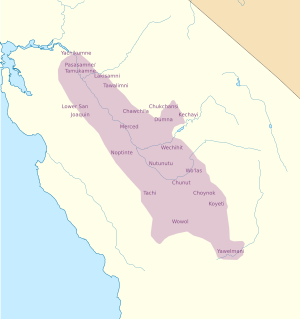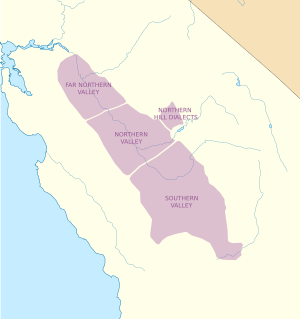Valley Yokuts facts for kids
Quick facts for kids Valley Yokuts |
|
|---|---|
| Region | San Joaquin Valley, California |
| Ethnicity | Yokuts |
| Native speakers | unknown (2007) 20–25 fluent and semi-speakers |
| Language family | |
| Dialects | |

Historical distribution with dialects
|
|
Valley Yokuts is a group of related ways of speaking, also known as dialects. These dialects are part of the larger Yokutsan language family. People in the San Joaquin Valley, California, once spoke these languages.
Today, the Chukchansi language is still spoken by some people. It even has special language classes and a preschool for children. It is also taught in a local elementary school. Another dialect, Tachi, no longer has native speakers. However, it has a Headstart program to help teach the language to young children.
Contents
Different Valley Yokuts Dialects
Valley Yokuts is sometimes thought of as three main languages. Each of these main groups has its own unique dialects.
Far Northern Valley Yokuts
This group of dialects is no longer spoken. It is also known as Delta Yokuts.
- Yachikumne (also called Chulamni)
- Chalostaca
- Lakisamni
- Tawalimni
Northern Valley Yokuts
This group includes several dialects.
- Nopṭinṭe
- Chawchila
- Chukchansi
- Kechayi
- Dumna
Southern Valley Yokuts
This group has many dialects.
- Wechihit
- Nutunutu–Tachi
- Chunut (also called Sumtache)
- Wo’lasi–Choynok
- Wowol
- Telamni
- Koyeti–Yawelmani
Of these, the Yawelmani dialect is the most studied. It is also known as Yowlumni. You can learn more about the Chukchansi dialect too.
How Valley Yokuts Works: Grammar Basics
Like all languages, Valley Yokuts has rules for how words are formed and used. This is called grammar. Here are a few interesting parts of Valley Yokuts grammar.
Changing Word Sounds: Ablaut
One interesting feature is called ablaut. This means the vowel sound inside a word changes to show a different meaning or tense. It's a bit like how in English, "sing" changes to "sang" for the past tense.
For example, look at the word deeyi, which means 'to lead':
- deeyen means 'he will lead' (the 'ee' sound changes)
- deyhin means 'he led' (the 'ee' sound changes again)
Adding Endings: Suffixes
Valley Yokuts also uses suffixes. A suffix is a small part added to the end of a word to change its meaning.
- diyhatinhin means 'he wanted to lead' (-hatinhin is added)
- diyee’iy means 'place where one got the lead' (-ee’iy is added)
- diyaa’an means 'he is leading' (-aa’an is added)
Repeating Parts of Words: Reduplication
Another way words change is through reduplication. This is when a part of a word is repeated. In Valley Yokuts, repeating a part of a word often means something happens "often" or "repeatedly."
- ’ɔɔṭ’hun means 'he stole'
- ’ɔɔṭ’uṭ’hun means 'he stole often' (the ’uṭ’ part is repeated)
- ’ɔɔṭ’al means 'he might steal'
- ’ɔɔṭ’uṭ’al means 'he might steal often' (the ’uṭ’ part is repeated)


